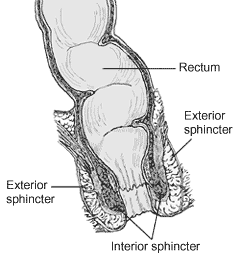 Image via Wikipedia
Image via Wikipedia
Many things are associated with hemorrhoids like ulcers and Crohn disease. Many women who get hemorrhoids get it because of their pregnancy, although it is undetermined why pregnant women get hemorrhoids. Believe it or not, hemorrhoids are present in healthy individuals; they are present in everyone. The only thing is that when they swell or enlarge they can become quite discomforting and painful. It is when the vascular cushions become enlarged, inflamed, or protruding when they are called hemorrhoids.
Some of the causes for hemorrhoids include your diet. For people who have a high fiber diet, they may get hemorrhoids because of the frequency of passings. Pregnancy is another cause, but it could be the extra pressure from the added body weight. Prolonged sitting on a toilet can also be the cause for hemorrhoids. Aging also causes hemorrhoids because the tissue inside the rectum begins to deteriorate. The weakening of the tissue can start as early as thirty. Straining and constipation has also been known to be a cause for hemorrhoids.
Symptoms are divided into external and internal. Internal does not cause pain, but external can cause discomfort, pain, and bleeding. Protruding hemorrhoids can be itchy and bleed. They require medical attention because they are so uncomfortable. Internal hemorrhoids will cause discomfort and will make a person feel pressure around the abdomen and anus.
The pain you may feel from internal hemorrhoids is caused by a spasm in the sphincter. Internal hemorrhoids are mostly painless and have bleeding with bowel movements. When the hemorrhoid puts pressure on the hemorrhoid veins, they tend to break and blood will appear. Internal hemorrhoids can also produce mucus that will keep the area moist and cause the anus to itch, although this is not common.
Most hemorrhoids will only be treated if they cause any discomfort or pain. They will heal, but it may cause some scarring, depending on how serious your condition is. For external hemorrhoids, you may have an extra deposit of skin that will be permanent. If you feel any discomfort or pain, you should seek medical attention and consult your physician. Everyone has hemorrhoids; it’s just a matter of how serious. You may need to consult your doctor if your hemorrhoids seem to be enlarged or blood is located in your stool.
![Reblog this post [with Zemanta]](http://img.zemanta.com/reblog_e.png?x-id=48d702eb-0321-45ca-ae4f-12b9f5921b79)
No comments:
Post a Comment